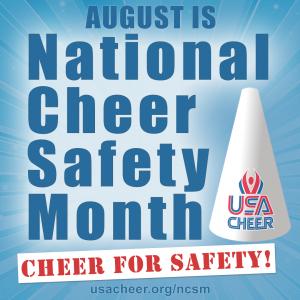Cheerleading Safety Soars: Catastrophic Injuries Nearly Eliminated, Injury Rates Now Lower Than Many Sports
Catastrophic Injuries at Record Lows, Injury Rates Lower Than Other Sports, Emergency Room Visits Declined Significantly, Still More to be Done
DALLAS, TX, UNITED STATES, August 4, 2025 /EINPresswire.com/ -- Once perceived as a high-risk activity, cheerleading has undergone a remarkable transformation in safety. Today, it ranks among the safest high school sports in the United States, with catastrophic injuries nearly eliminated, injury rates lower than many contact sports, and a significant decline in emergency room visits over the last decade.Catastrophic Injuries at Record Lows
According to the National Center for Catastrophic Sport Injury Research (NCCSIR), catastrophic injuries in cheerleading have dropped significantly, resulting in a decrease of 85% in the total number of catastrophic injuries from 42 in 2003-2014 to 6 in 2014-2023. The most recent 2023 NCCSIR Annual Report shows no direct fatal or permanently disabling injuries in cheerleading in the past two years.
Injury Rates Lower Than Other Sports
Injury rate comparisons also tell a compelling story. Based on surveillance data from High School RIO (Reporting Information Online)—a national system that tracks injuries via certified athletic trainers—cheerleading again ranked 17th out of 20 sports in injury rates for the 2023–2024 school year. Cheerleading showed 1.05 injuries per 1,000 athletic exposures, nearly half the average sports rate of 2.03 per 1,000 AE and lower than eight other girls’ sports.
Emergency Room Visits Declined Significantly
A study from the Orthopedic Journal of Sports Medicine based on information from the National Electronic Injury Surveillance System (NEISS) found that cheerleading-related ER visits declined by 15% from 2010 to 2019. ER visits remain at 2019 levels, even with cheerleading back at full strength and with increased participation since COVID. Additional data shows that, consistent with previous years, cheerleading emergency room visits are lower than those of girls' basketball, soccer, volleyball, and softball for the same age range.
Still More to be Done
While many indicators point to major safety improvements and a positive trajectory, there are areas that can still be addressed. Data from the High School RIO reporting system shows that concussion rates increased compared to previous years. The NFHS/USA Cheer Rules Committee and USA Cheer Safety Council have reviewed the available material, and although there doesn't appear to be a specific rule change pointing to the increase, we will continue to monitor the data actively. While some of the increase can be attributed to better concussion awareness and adherence to concussion reporting protocols, addressing and minimizing head injury remains a priority in the cheer community. As practice settings make up the majority of concussion incidents, increased vigilance in following skill progressions and monitoring fatigue during practice is strongly recommended.
What’s Driving Safety Improvements?
Cheerleading’s safety gains are the result of coordinated action across multiple levels of the sport:
• Stricter Regulations – While continuing to allow cheerleading skills to evolve with the ever-increasing athletic abilities of participants, cheerleading rules makers such as USA Cheer and the NFHS have addressed and restricted certain higher-risk skills, such as double-twisting dismounts for high school age and younger, and eliminated basket tosses from junior high and younger. Specific skill-based surface restrictions have also had major impacts on cheerleading safety. According to the NCCSIR, “rule changes in basket toss in 2006/07 resulted in a 4-fold reduction in basket toss injuries.”
• Certified Coaching – Many state high school associations, coaches' associations, camp organizations, and event producers require membership and safety training through USA Cheer. Membership in USA Cheer provides coaches with training in safety, risk minimization, concussion protocols, and skill progressions.
• Data-Informed Rule Changes – Injury surveillance systems like High School RIO™ help policymakers adapt safety rules in response to real-time data.
• Improved Practice Environments – Widespread use of mats, proper flooring, and safer practice techniques has reduced impact injuries.
• Cultural Shift Toward Athlete Health – There's growing emphasis on conditioning, athlete well-being, and injury prevention. As institutions recognize the athleticism involved in cheer, more programs are providing access to athletic trainers, physicians, and healthcare providers.
Cheerleading: A Safe, Competitive, and Evolving Sport
“We are proud of how far the sport has come,” said Jim Lord, Director of Education and Programs at USA Cheer. “Today, cheerleading is a rigorous, athletic, and safe sport — and it continues to set an example in how youth sports safety can evolve through evidence-based policy and a commitment to athlete well-being.”
________________________________________
Sources Cited:
1. High School RIO™ – https://www.datalyscenter.org/wp-content/uploads/2025/07/2023-24-High-School-RIO-CONVENIENCE-Summary-Report.pdf
2. NCCSIR Annual Report – https://nccsir.unc.edu/reports/
3. Xu AL, Suresh KV, Lee RJ. Progress in Cheerleading Safety: Update on the Epidemiology of Cheerleading Injuries Presenting to US Emergency Departments, 2010-2019. Orthop J Sports Med. 2021 Oct 13;9(10):23259671211038895. doi: 10.1177/23259671211038895. PMID: 34676270; PMCID: PMC8524718.
4. NEISS Injury Data – https://www.cpsc.gov/Research--Statistics/NEISS-Injury-Data
5. USA Cheer Safety Resources – https://www.usacheer.org/safety/research
Jim Lord
USA Cheer
media@usacheer.org
Visit us on social media:
LinkedIn
Instagram
Facebook
YouTube
TikTok
X
Legal Disclaimer:
EIN Presswire provides this news content "as is" without warranty of any kind. We do not accept any responsibility or liability for the accuracy, content, images, videos, licenses, completeness, legality, or reliability of the information contained in this article. If you have any complaints or copyright issues related to this article, kindly contact the author above.



